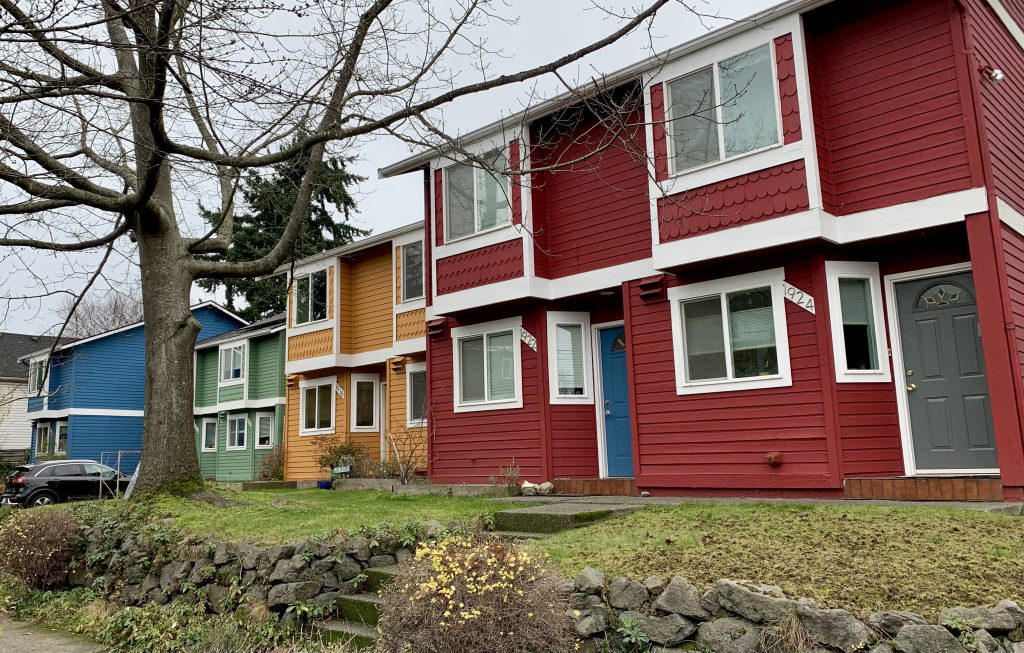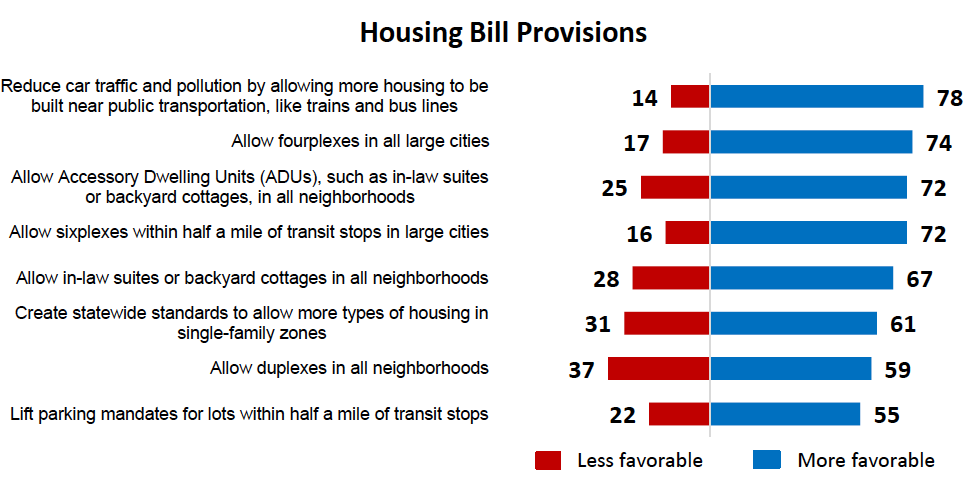
Housing abundance is returning as a big policy issue in the 2023 Washington legislative session. On Tuesday, Rep. Jessica Bateman (D-Olympia) filed her eagerly-awaited bill, HB 1110, that would broadly allow missing middle housing in cities throughout the state, with the biggest impact in the major metropolitan areas. The bill could help pave the way for a huge production bump in triplexes, fourplexes and even sixplexes across the state.
Those housing types used to be very common in Washington State until municipalities by and large made them illegal during the post-war White Flight era by ratcheting up restrictive single family zoning. Suburban sprawl became the main way cities grew, but eventually they ran out of space for such low-density development and were slow to relegalize apartments and townhomes in most areas to compensate. Hence, over time multiplexes and small apartment buildings became “missing middle” housing in most cities, and, relatedly, housing prices soared.

The average Washington State home price is up 44.5% in the last two years, surpassing $616,000, according to Zillow. Supporters of zoning reform point to the unsustainable trend in housing prices and continued underproduction of housing to underscore the need to act with urgency.
The bill, HB 1110, is a successor to a similar one that Rep. Bateman authored last year: HB 1782. One difference, though, is that this year’s bill has a Republican co-sponsor in Rep. Andrew Barkis of the 2nd Legislative District. Other co-sponsors haven’t been announced yet, but Rep. Barkis — assuming he remains a supporter throughout the process — gives the legislation an extra vote, which could be sorely needed considering the effort fizzled last year without making it to a floor vote.
While garnering no Republican support last year, the bill also suffered considerable resistance within the Democratic caucus despite ardent support from the figurehead of the state party in Governor Jay Inslee. Even with a 57-41 Democratic advantage in the House last year, defections and a lack of Republican support were enough to kill the bill. Supporters hope this year will be different.
New language in HB 1110
The bill contains some big changes from the predecessor last year. For starters, missing middle zoning reforms kick in at a much lower population floor (6,000 residents in a city instead of 20,000). That means it would apply to smaller suburban cities like Newcastle and Lake Forest Park. Even Medina, the tiny megarich enclave on Lake Washington, would not be exempt due to a provision applying the bill to any city near a city with more than 200,000 residents.
While this iteration includes sixplexes within a half-mile of frequent transit, as did Bateman’s original draft last year, outside of those areas builders would need to price two units below market and affordable to those making 80% of area median income in order to qualify for the added capacity to build sixplexes. Many market-rate developers may just opt to build fourplexes to avoid the affordability requirement, but it does give nonprofit builders (e.g., Habitat for Humanity) more options.
“This option would incentivize affordable housing without the risk of affordability mandates making fourplexes financially infeasible to build,” Sightline’s Dan Bertolet wrote in his recent rundown.

Another key distinguishing feature of the bill is its approach to addressing the problem of displacement among low income renters and communities of color.
Following last year’s HB 1220, a bill which Futurewise described as “poised to change WA’s housing landscape,” the new missing middle bill requires cities to add an anti-displacement measure to the housing element of their comprehensive plans within nine months of the bill’s passage. This would entail identifying communities at risk of displacement by new development, chiefly low-income communities of color that have historically borne the brunt of the harm inflicted by exclusionary housing policies. The anti-displacement provision would also apply to all areas within a half-mile of a major transit stop.
The nine-month requirement would put anti-displacement efforts ahead of other changes spurred on by the bill. While infill approaches to increasing housing, like missing middle housing reform, have typically been viewed as positive for building affordable- to moderately-priced housing, the competitiveness of the current housing market has led some to question if a surge of missing middle housing development could incite displacement. This provision appears aimed at preemptively tackling that criticism and potential outcome.
More details on HB 1110
In broad strokes, here’s how Rep. Bateman’s first cut at the legislation shakes out:
- Cities planning under the Growth Management Act and having a population of at least 6,000 residents or any city of any size in an Urban Growth Area contiguous with Seattle, Tacoma, or Spokane would need to adopt missing middle housing* zoning reforms;
- A city would have to allow at least four homes on each residentially-zoned lot outright and six homes on each residentially–zoned lot if at least two homes are made affordable or the lot is within a half-mile of a major transit stop**;
- Off-street car parking mandates would be restrained with no parking mandatable within a half-mile of a major transit stop, one parking space mandatable on lots less than 6,000 square feet in size, and two parking spaces mandatable on lots greater than 6,000 square feet in size;
- Development and design standards would need to be objective and and not designed to discourage missing middle housing;
- Review processes and critical areas regulations would need to be the same for missing middle housing as detached single-family homes;
- Implementation of zoning changes by cities under the law would be exempt from appeals under the Growth Management Act and State Environmental Policy Act; and
- New covenants, restrictions, and homeowners’ associations created after implementation of the legislation would not be able to prohibit missing middle housing.
Implementation of missing middle zoning reforms would be phased in. Larger cities with a population of at least 10,000 would have two years to adopt changes while smaller cities with a population of less than 10,000 and meeting the statutory thresholds would have one year. Based upon the text of the legislation, cities that reach statutory thresholds in future years would also have to implement zoning changes within one year.
Cities, however, could apply for an extension to delay implementation of zoning changes in specific areas. A city choosing to do this would need to document that water, sewer, or stormwater service deficiencies exist or will exist within the next five years and develop an action plan to remedy such deficiencies on a specified timeline.
The Washington State Department of Commerce would be tapped to provide technical assistance to cities, establish a process to approve city actions to implement zoning reforms, and publish a model missing middle housing zoning reform ordinance. In the event that a city required to implement the zoning reform failed or refused to do so before statutory deadlines, the model ordinance would preempt and supersede a city’s local zoning ordinance where in conflict.
While this legislation is a big leap forward, it still leaves out unincorporated Urban Growth Areas, which form a very large proportion of urban lands in places like Snohomish and Pierce Counties. Some of those areas are even slated to get big regional transit investments like Link light rail (e.g., Ash Way and Mariner in Snohomish County) and bus rapid transit (e.g., Parkland and Spanaway in Pierce County) in the next decade or so.
New path to passage
Supporters have reason to hope that HB 1110 can overcome the challenges that doomed its predecessor. In short, they expect that stronger support within the Democratic caucus plus a little help from Republicans should be enough cushion to overcome the obstacles sure to arise.
Democrats picked up another House seat, making a gain in Legislative District 10, and defending all their seats. One skeptic in Steve Conway (D-Tacoma) retired and was replaced by a firm supporter in Sharlett Mena. Barkis has signed on to the bill, perhaps opening the door to further Republican support.
A February poll indicated 61% of Washingtonians support legislation to increase production of missing middle housing and most want the state to intervene. Some cities have already taken the lead. After HB 1782 failed, Spokane took the initiative to pass citywide fourplex zoning via a pilot program.

Both labor and business leaders have indicated statewide zoning reform is among their top priorities. Those powerful backers join its traditional base support among urbanists and pro-housing advocates, including groups like Futurewise, Sierra Club, and Sightline. During our legislative preview event last month, Futurewise’s Government Affairs Director Bryce Yadon told The Urbanist that he believes the bill would have enough votes to pass this year thanks to that stronger coalition and strategic changes to the legislation
If that weren’t enough, House Democrats set up a new housing committee to streamline the process of moving housing legislative and ousted Rep. Gerry Pollet (D-Seattle) from Local Government committee. As committee chair, Pollet had obstructed a number of housing bills, including gutting Bateman’s bill and removing the sixplex provision before passing it out of his committee last year. The new chair, Davina Duerr, co-sponsored HB 1782, and incidentally The Urbanist named her state lawmaker “hero” of the year.

The first day of session is January 9, and the house of origin cutoff is typically in mid-February, leading to the first big culling of bills. This illustrates how quickly bills have to move to survive in Washington State’s part-time legislature setup, with the short legislative sessions that entails. Hopefully, lawmakers can thread the needle this time around.




